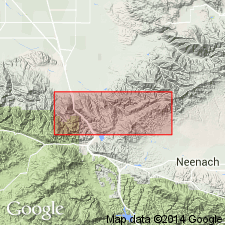
- Usage in publication:
-
- Metralla sandstone member
- Modifications:
-
- Named
- Biostratigraphic dating
- Dominant lithology:
-
- Sandstone
- AAPG geologic province:
-
- Transverse Ranges province
Summary:
Named as second from uppermost member (of 4) of Tejon formation. Type locality designated in Reed Canyon, Tehachapi Mountains, Kern Co, CA in type area of Tejon formation. Thickness is 1300 ft. Consists of concretionary gray sandstone. Conformably underlies Reed Canyon silt member; conformably overlies Liveoak member (both new and of Tejon formation). Age is Eocene based on PTERIA PELLUCIDA, NONIOELLA FRANKEI, PLECTOFRONDICULARIA COOKEI.
Source: GNU records (USGS DDS-6; Menlo GNULEX).
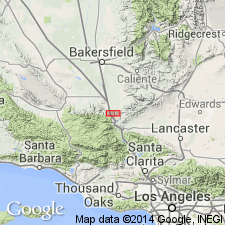
- Usage in publication:
-
- Metralla sandstone member
- Modifications:
-
- Age modified
- AAPG geologic province:
-
- Transverse Ranges province
Summary:
Consists of fine- to medium-grained sandstones which are uniformly gray, massive, and well-indurated by calcareous cement. Contain large number of spherical concretions which range up to 10 feet in diameter. These weather out of the massive sandstone matrix and lie scattered upon surface of ground. Is 1300 feet thick in Reed Canyon. Does not occur in Liveoak Canyon. Age is middle to late Eocene based on molluscan fauna.
Source: GNU records (USGS DDS-6; Menlo GNULEX).
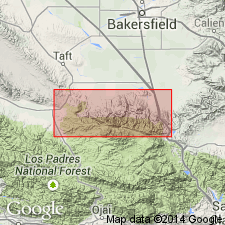
- Usage in publication:
-
- Metralla Sandstone Member*
- Modifications:
-
- Adopted
- AAPG geologic province:
-
- Transverse Ranges province
Summary:
Metralla Sandstone Member (2nd from uppermost member of Tejon Formation) is regressive sandstone which is locally conglomeratic and contains abundant shallow marine megafauna in its eastern exposures but which grades laterally westward into fine-grained, thinner bedded sandstones characterized by lack of megafauna, abundant synsedimentary slumps and some flysch-type sedimentary structure. Locally contains thin layers of coal and other carbonaceous debris; probably deposited in shallow marine and brackish-water environments. Overlain by thin (0 to 200 ft) silty shale of Reed Canyon Siltstone Member (Tejon Formation).
Source: GNU records (USGS DDS-6; Menlo GNULEX).
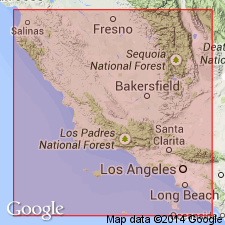
- Usage in publication:
-
- Metralla Sandstone Member*
- Modifications:
-
- Overview
- AAPG geologic province:
-
- Transverse Ranges province
Summary:
Consists of shallow marine, megafossil-rich, conglomerate sandstone characterized by cross bedding and ripple marking in the east and deeper marine, microfossil-rich, finer-grained sandstone characterized by graded bedding, Bouma sequences and sole markings in the west. Is about 2000 ft thick near Pleito Creek; further west it thins to form turbidite sequence that interfingers with siltstone and shale of Liveoak Shale Member (Tejon Formation) near San Emigdio Canyon. Conformably underlies Tecuya Formation to the east, Reed Canyon Siltstone Member in central part, and San Emigdio Formation in western part of area. Megafauna and microfauna indicate late Eocene age with unit younger to the west, suggesting late Eocene westward regression.
Source: GNU records (USGS DDS-6; Menlo GNULEX).
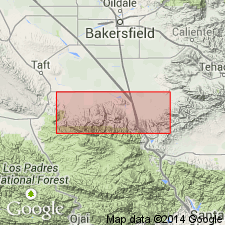
- Usage in publication:
-
- Metralla Sandstone Member*
- Modifications:
-
- Reference
- Age modified
- AAPG geologic province:
-
- Transverse Ranges province
Summary:
Measured reference section (2,114 ft thick) designated at Colorful Creek, 1 mi west of Tecuya Creek along creek bottom and on ridge crest to west, SE/4 sec.27 T10N R20W, Grapevine 7.5' quad, Kern Co, CA. Age is middle Eocene on basis of Narizian microfossils.
Source: GNU records (USGS DDS-6; Menlo GNULEX).
For more information, please contact Nancy Stamm, Geologic Names Committee Secretary.
Asterisk (*) indicates published by U.S. Geological Survey authors.
"No current usage" (†) implies that a name has been abandoned or has fallen into disuse. Former usage and, if known, replacement name given in parentheses ( ).
Slash (/) indicates name conflicts with nomenclatural guidelines (CSN, 1933; ACSN, 1961, 1970; NACSN, 1983, 2005, 2021). May be explained within brackets ([ ]).

